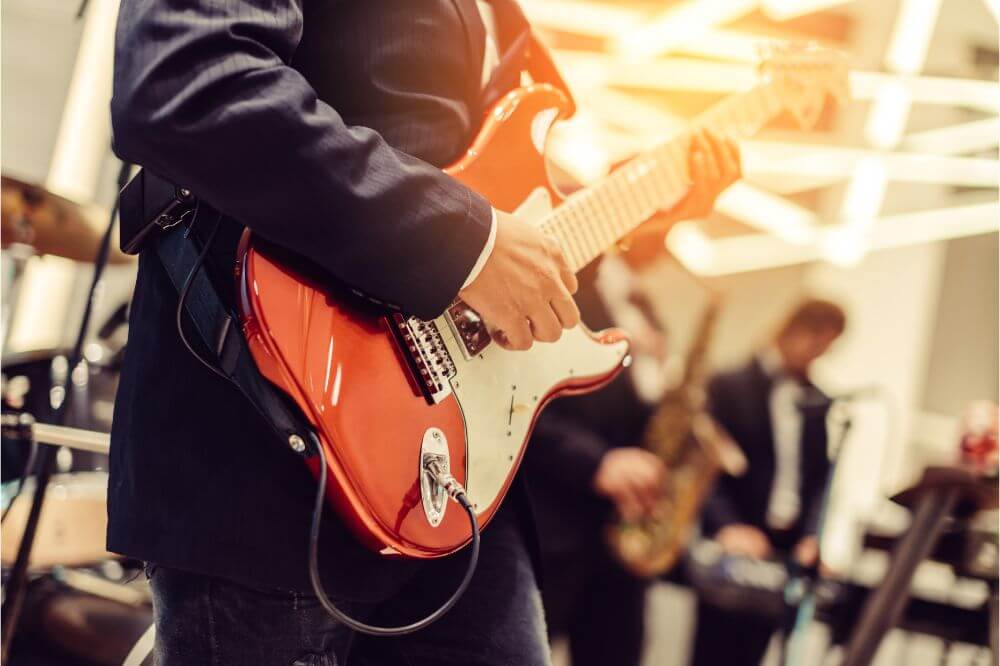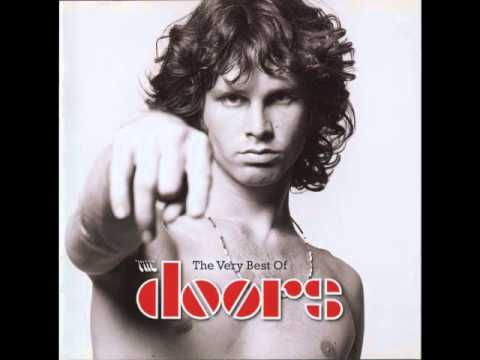Whether you’re just starting out playing guitar or want to know more about one of the world’s most exciting and versatile instruments, it’s essential to know the proper terminology you might come across while doing your research. In this article, we will dive into the differences between a lead vs rhythm guitar.
What is a lead guitar?
A lead guitar is often also known as a solo guitar. Someone who plays a lead guitar might be accompanied or supported by a rhythm guitar, but it isn’t mandatory. Lead guitarists usually have more freedom to be creative, as their job is to support the drummer and the bassists.
When listening to a performance with both a lead and a rhythm guitar, the lead guitar will be the one cutting through with single notes and riffs. The lead guitar also supports chord progression and helps with the beat of the music.
In general, a lead guitarist will have a sharper sound to it so that the notes can cut through the rest of the performance while focusing on technique and timing.
What is a rhythm guitar?
On the opposite end, rhythm guitar focuses on supporting the vocalist. Much like its name, rhythm guitarists focus on rhythm and melody. With the use of chord structures, a rhythm guitar helps add harmony.
Rhythm guitar is also used as a sort of melodic bridge between the other instruments, and melody, and the groove. Someone who plays a rhythm guitar in a band may also add embellishments, like solos, scales, and vibrato.
For the most part, rhythm guitar has a warm and mellow sound that can support the melody and rhythm of the entire performance.
What is the difference?
Interestingly enough, lead guitar and rhythm guitar are not two different instruments. They simply describe a role assigned to the guitar and the player. A guitarist can play both roles on the same guitar. The main differences between lead and rhythm depend on the guitar’s sound and the technique that the guitarist uses.
Sound
First, let’s take a look at the difference in sound or tone between the two guitar styles. Lead guitarists usually play individual notes and riffs, whereas rhythm guitars focus primarily on chords. While each guitar can play either role, the setup between them is slightly different so that the guitarist can do their job correctly.
The lead guitar must sound brighter, sharper, and just a touch louder than the rhythm guitar. This helps the guitarist allow the sound of their guitar to be heard over the other instruments and more correctly support the melody. If the sound of the lead guitar is too low, the sound can be drowned out by the bass or the drums.
Meanwhile, the rhythm guitar focuses on providing chord progression and an underlying beat or rhythm. This means that the sound must be softer and warmer, to work in harmony with the drums and bass. Think of the rhythm guitar as the backup singer, focusing on holding a foundation and tying everything together.
In terms of volume, sound engineers will almost always set the lead guitar at a higher volume than the rhythm guitar. This is also true for the gain and treble, allowing the lead guitar to have a crisp and bright sound.
As for the bass, the rhythm guitar has a more prominent low end, allowing it to complement the bass of the performance properly. And lastly, both the lead and the rhyme guitar need to have the proper mid-range tone so that the depth of sound flows well with the rest of the instruments.
Technique
While the sound is fundamental, there’s another thing that guitarists need to be mindful of when playing either lead or rhythm: the technique of their playing. To play guitar, one has a variety of techniques to choose from, but some will always be better for lead or rhythm, or vice versa.
A guitarist needs to have a good grasp of scales for lead guitar. This allows them to perform unforgettable solos. Vibrato and string bending – or pitch bends – are also crucial for a lead guitarist to know. These two techniques can add quite the emotional punch to any solo performance.
Hammer-ons and pull-offs are two techniques that work hand in hand to make a great lead guitarist. A hammer-on is when the guitarist holds down the fret while pressing down on a higher fret with another finger, allowing the higher note to echo. Meanwhile, a pull-off happens when you release the higher fret, making sure the low note is the star of the show. These actions happen without striking the string with the pick.
When it comes to rhythm guitar techniques, a good rhythm guitarist will perfect rhythm and timing. This is a rhythm guitarist’s bread and butter and allows them to work in harmony with the drums and bass.
Having excellent chord technique is another must-have for the rhythm guitar. It’s one of the most important things that a guitarist needs. Switching between chords, knowing all the names of the major and minor chords, and being able to execute them flawlessly makes up the bulk of a rhythm guitarist’s knowledge.
Rhythm guitar must also have a good strumming and palm muting technique. Using different strumming patterns allows a rhythm guitarist to control the melody better, while palm muting helps muffle the sound of a chord, giving the lead guitar some time to shine.

Where do you hear the rhythm guitar?
In music, there are generally three layers: top layer, middle layer, and bottom layer. These can also be known as left, right, and center layers.
The top layer is where you often hear the melody. This is where you would generally head the lead guitar and the vocals. It’s the part of the three layers that generally need to be the loudest and most prominent.
The middle layer, however, is where the rhythm guitar rests. When listening to music, listeners don’t often “hear” the rhythm guitar. This is intentional. The middle or center layer usually consists of the rhythm guitar and the bass. The sounds of these instruments are meant to blend in the background while providing support for the melody.
And finally, the bottom layer is created by the percussion instruments or the drums. This layer is responsible for the underlying beat of the music, and both the top and middle layers need to work in harmony with it to make the song sound good.
Where do you hear the lead guitar?
Now that we know the lead guitar is usually in the top layer let’s look at where a lead guitar should be most present in specific parts of the song.
Lead guitars are often responsible for the introduction of the song. Introductions are often short, usually anywhere from 4 to 8 bars. Introductions build towards introducing the vocals and the rest of the music. The introduction is meant to be both memorable and instantly recognizable. Think Mister Brightside by The Killers.
The lead guitar is also responsible for the chorus, supporting the vocalist with a hook, keeping it simple to draw attention to the words. Lead guitars are also present during the bridge and the verse. Lead guitarists need to know when to play to fill the breaks between the vocalist’s lines.
Which is best for beginners?
When it comes to lead vs. rhythm guitar, which is best for beginners to learn first? Regarding the ease of technique and the understanding of how to play guitar, rhythm guitar is often better for newcomers.
Rhythm guitar allows new guitarists to get acquainted with basic chord playing, strumming, and other beginner techniques. Meanwhile, lead guitar relies on those underlying foundations to build up to a more complex playing style.
Most guitarists will give this advice: it’s essential to learn to play both rhythm and lead! Building on your skill set will allow you to become a more well-rounded player and an invaluable band member.
The more a beginner guitarist learns about playing rhythm, music theory, and building up skills, the easier it will be to pick up lead guitarist skills later down the road.
Conclusion
So, what’s the difference between lead vs. rhythm guitar? Both more and less than you might think! A guitarist can play both roles on the same instrument, but how the instrument sounds and the techniques a guitarist uses make up the bulk of the differences.
Rhythm guitar focuses on building up that middle layer in music, supporting the bass and drums. Meanwhile, the lead guitar supports the vocalist and is often louder and sharper in terms of sound to be heard over the rest of the instruments.
Lead guitarists often have a lot more freedom while playing, exploring with embellishments and solos, while rhythm guitarists must keep up the foundation of the music with chords.
When learning guitar, building up a good foundation of technique with rhythm guitar can eventually lead to good technique with a lead guitar.




















